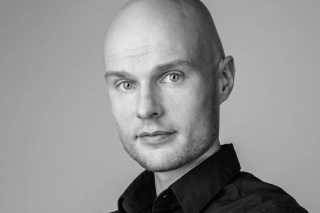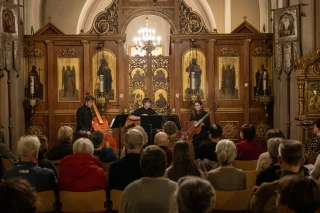Barokin loistoa ja kauneutta
sol. Petteri Pitko, cembalo
Wasa Consort;
Eero Marttila & Elena Hämäläinen, gamba
Pontus Grans, violone
Monteverdi – Gabrieli – Hume – Lupo – Byrd – Gibbons – Saariaho
Johann Sebastian Bach:
Brandenburg Concerto No 5 in D Major
sol. Erica Nygård, flute & Martin Granström, violin
Georg Friedrich Händel:
Parts from the series Water Music and Music for the Royal Fireworks
Program
Toccata (from the opera L’Orfeo, 1607)
Ricercar per sonar à 8 (1587)
Canzona à 12 (1597)
Fantasia
Musick and Mirthe – The Lady Hatton’s Delight (1607)
Fantasia cembalolle (kokoelmasta My Ladye Nevell’s booke, 1591)
Fantasia
Galliard
“The spirit of gambo” (1607)
Canzona in Echo à 10 (1597)
Jardin Secret II for cembalo and soundbite (1986)
Brandenburg Concerto No 5 in D Major, BWV 1050 (1721)
1. Allegro
2. Affettuoso
3. Allegro
Suite imaginaire – parts from Music for the Royal Fireworks (1749) ja Water Music (1717)
Ouverture
Sarabande
Rigaudon I & II
Menuet I & II
La Paix
La Réjouissance
Minuet
Artists

Petteri Pitko, cembalo & musical leading
Petteri Pitko performs as a harpsichordist, organist, and keyboard player, with a repertoire that spans from early Baroque to the most contemporary music. Alongside his artistic work, he serves as a lecturer in early music at the Novia University of Applied Sciences in Jakobstad.
He has appeared as a soloist with the baroque orchestra Akademie für Alte Musik Berlin, Ensemble Resonanz, the Zurich Chamber Orchestra, Tapiola Sinfonietta, the Ostrobothnian Chamber Orchestra, and the Lapland Chamber Orchestra, as well as a chamber musician at numerous music festivals in Finland, across Europe, the Canary Islands, the United States, China, and South Korea.
As an orchestral and continuo musician, he has worked with the Berlin Philharmonic, Akademie für Alte Musik Berlin, RIAS Chamber Choir, Berlin Radio Choir, WDR Radio Choir, Stavanger Symphony Orchestra, Finnish Radio Symphony Orchestra, Helsinki Philharmonic Orchestra, and Tampere Philharmonic Orchestra. He was the Artistic Director of the Finnish Baroque Orchestra (FiBO) from 2018 to 2022.
 Wasa Consort;
Wasa Consort;
Elenä Hämäläinen & Eero Marttila, gamba
Pontus Grans, violone
Eero Marttila, Elena Hämäläinen, and Pontus Grans. have studied Baroque music at the Novia University of Applied Sciences in Jakobstad. Elena and Pontus completed their four-year studies last spring, while Eero is currently in his final year. Elena began her studies with the Baroque cello, and Pontus and Eero with the Baroque bass. However, during their studies, all three became interested in instruments of the viol family. Eero and Elena took up the bass viol, and Pontus the violone. Wasa Consort was founded at the beginning of 2024, and the ensemble has been performing actively throughout Ostrobothnia.
Instrument presentation:
The viola da gamba traces its roots back to the late 15th century. At that time, the vihuela, a Spanish string instrument used during the Renaissance, spread to Italy. The Italians developed from it their own instrument — a “violin” played on the lap (da gamba = “of the leg”). Viols come in various sizes and shapes. The largest and lowest-pitched are called violones, while the next lowest are bass viols.
With Italian musicians, the viol spread to England in the early 16th century. There it became especially popular among amateurs, and many aristocratic or well-to-do households owned viols of different sizes. Thanks to its fretted fingerboard, the instrument was considered approachable for anyone, regardless of their ear for pitch.
Many English monarchs were also fond of viol music. Court composers wrote works for viol consorts as well as for small mixed ensembles (broken consorts) that included one or more viols. Among the composers serving at the court of Queen Elizabeth I were Thomas Lupo, Orlando Gibbons, Thomas Tomkins, Thomas Morley, and William Byrd. Playing the viol was also part of the education of Elizabeth I’s sons. A true individualist of his time was the Scottish musician Tobias Hume, both a professional soldier and a brilliant viol virtuoso.
Equality between the different voices is characteristic of consort music. Public performance was by no means the main purpose of these compositions; rather, the consort was likely a popular form of social evening entertainment — friends and family gathering in a room to play harmonious music together, perhaps by the fireside with a glass of good wine. At its best, the act of playing resembles a conversation, where independent melodies and rhythms intertwine seamlessly. The most common compositional form is the fantasia, strongly associated with a sense of freedom for both composer and performer, and characterized by division into contrasting sections.

